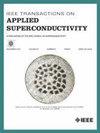Quench Modeling of the GaToroid Demonstrator Magnet for Hadron Therapy
IF 1.7
3区 物理与天体物理
Q3 ENGINEERING, ELECTRICAL & ELECTRONIC
引用次数: 0
Abstract
In the design of superconducting magnets, ensuring thermal stability during operation is of paramount importance. This study aims to predict heat propagation and temperature distribution during a quench event in the Low Temperature Superconductor (LTS) demonstrator of the GaToroid coil. An efficient 1-D Finite Element Method (FEM) quench propagation model was employed, incorporating a thermal network model to account for heat interactions between turns in the transverse direction. The study highlights the relevance of accounting for the transverse propagation for an accurate description of the normal zone propagation. The predicted numerical results are validated against experimental data obtained during a dedicated test campaign.求助全文
约1分钟内获得全文
求助全文
来源期刊

IEEE Transactions on Applied Superconductivity
工程技术-工程:电子与电气
CiteScore
3.50
自引率
33.30%
发文量
650
审稿时长
2.3 months
期刊介绍:
IEEE Transactions on Applied Superconductivity (TAS) contains articles on the applications of superconductivity and other relevant technology. Electronic applications include analog and digital circuits employing thin films and active devices such as Josephson junctions. Large scale applications include magnets for power applications such as motors and generators, for magnetic resonance, for accelerators, and cable applications such as power transmission.
 求助内容:
求助内容: 应助结果提醒方式:
应助结果提醒方式:


